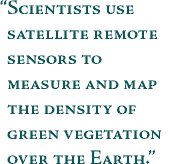

| |||
Though we often take the plants and trees around us for granted, almost every aspect of our lives depends upon them. They feed us, clothe us, absorb carbon dioxide, provide us with oxygen, and give us building materials and medications. When drastic changes occur to the vegetation around us, our health, economy, and environment are all affected. Twenty-five years ago, for instance, thousands of people starved when the vegetation in the Sahel region of Africa dried up during an extended drought. Over the past five decades deforestation in South America has left thousands of acres fallow and has destroyed many species including possible valuable medications.
In an effort to monitor major fluctuations in vegetation and understand how they affect the environment, 20 years ago Earth scientists began using satellite remote sensors to measure and map the density of green vegetation over the Earth. Using NOAA’s Advanced Very High Resolution Radiometer (AVHRR), scientists have been collecting images of our planet’s surface. By carefully measuring the wavelengths and intensity of visible and near-infrared light reflected by the land surface back up into space, scientists use an algorithm called a "Vegetation Index" to quantify the concentrations of green leaf vegetation around the globe. Then by combining the daily Vegetation Indices into 8-, 16-, or 30-day composites, scientists create detailed maps of the Earth’s green vegetation density that identify where plants are thriving and where they are under stress (i.e., due to lack of water). |
 Measuring Vegetation (NDVI & EVI)
| ||